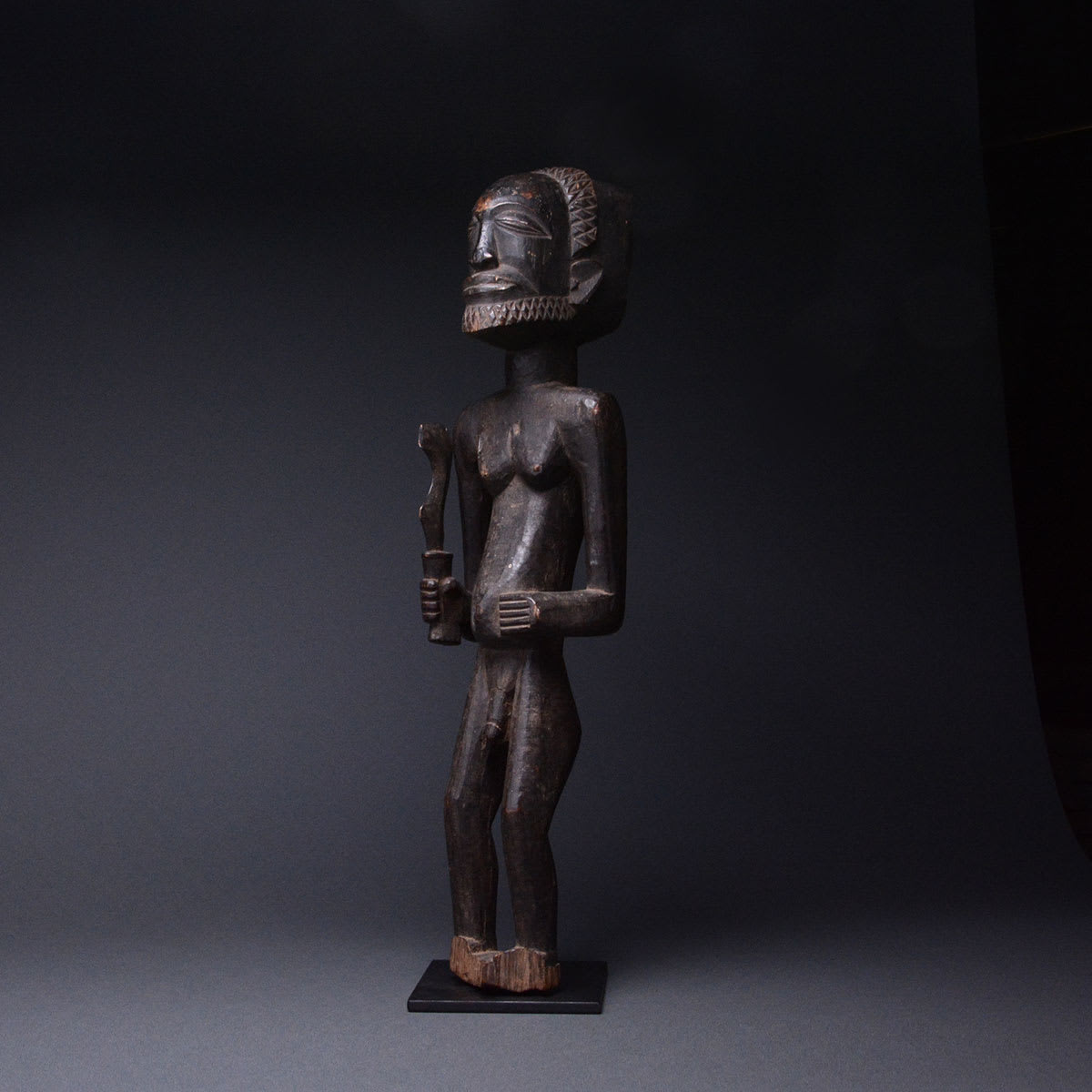Hemba Warrior Figure, 20th Century CE
Wood
height 68.6 cm
height 27 in
height 27 in
DE.002 (LSO)
Further images
This elegant piece is a distinguished example of Hemba sculpture. It represents an armed man standing in an alert pose, with a very long torso, slender limbs, well coiffed hair...
This elegant piece is a distinguished example of Hemba sculpture. It represents an armed man standing in an alert pose, with a very long torso, slender limbs, well coiffed hair and a bearded face. The arms are flexed at the elbows, the knees slight bent and the right hand holds a hook-ended machete or short sword. The face is very dignified, that of a fully mature, older man. The figure is naked. Detailing is limited except for the hatching used to make up the hair. The rare of the columnar coiffure is rendered as a cross, in the traditional style. The colour of the wood is dark, but there is little evidence of encrusted patination or use wear.
The Hemba are an agriculturally-based group living on the banks of the Lualaba River, in what was once Zaire. They are arranged into large groups which approximate to clan, each of which has a common ancestor, and is headed by an elder known as the Fuma Mwalo. He is responsible for justice, receives tribute from his subordinates; his power is counterbalanced by secret societies called Bukazanzi (for men) and Bukibilo (for women). One of his other tasks is holding socially important sculptures that represent ancestors, the guiding force for much of Hemba society.
As stated, most sculptures pertain to ancestor worship, and it is notable that the Luba – with which the Hemba were long considered to be contiguous – have a similar system and presumably therefore a common ancestry. Their works can usually be differentiated, however, on the basis of carving subtlety, as well as – although something of a subjective measure – the quality of detailing, the serenity of expression and the somewhat impassive quality of most Hemba pieces. Masks are very rare – there are two types, the significance of which is currently unclear. In addition to prestige items such as stools, staffs and the like, there are three main types of figures. Ancestor statues are called Singiti, and are usually male. Warrior figures are uncommon, and resemble ancestors except for the fact that they are carrying weapons. Janus figures called Kabeja are kept by the Fumu Mwalo of each group, and are worshipped as the embodiment of protector spirits. This piece is thus one of the rare warrior figures, honouring some deceased, heroic ancestor; its large size indicates that it was once a social focus for a fairly substantial group.
This is an attractive and refined piece of African art, and would be a striking addition to any collection or sophisticated domestic environment.
The Hemba are an agriculturally-based group living on the banks of the Lualaba River, in what was once Zaire. They are arranged into large groups which approximate to clan, each of which has a common ancestor, and is headed by an elder known as the Fuma Mwalo. He is responsible for justice, receives tribute from his subordinates; his power is counterbalanced by secret societies called Bukazanzi (for men) and Bukibilo (for women). One of his other tasks is holding socially important sculptures that represent ancestors, the guiding force for much of Hemba society.
As stated, most sculptures pertain to ancestor worship, and it is notable that the Luba – with which the Hemba were long considered to be contiguous – have a similar system and presumably therefore a common ancestry. Their works can usually be differentiated, however, on the basis of carving subtlety, as well as – although something of a subjective measure – the quality of detailing, the serenity of expression and the somewhat impassive quality of most Hemba pieces. Masks are very rare – there are two types, the significance of which is currently unclear. In addition to prestige items such as stools, staffs and the like, there are three main types of figures. Ancestor statues are called Singiti, and are usually male. Warrior figures are uncommon, and resemble ancestors except for the fact that they are carrying weapons. Janus figures called Kabeja are kept by the Fumu Mwalo of each group, and are worshipped as the embodiment of protector spirits. This piece is thus one of the rare warrior figures, honouring some deceased, heroic ancestor; its large size indicates that it was once a social focus for a fairly substantial group.
This is an attractive and refined piece of African art, and would be a striking addition to any collection or sophisticated domestic environment.







